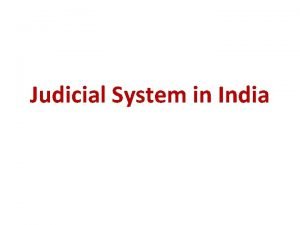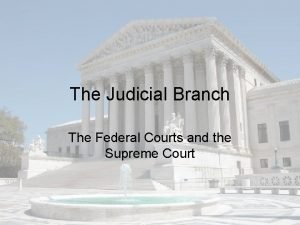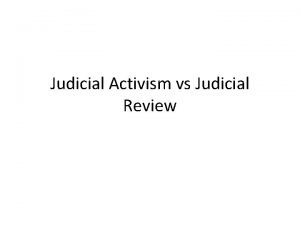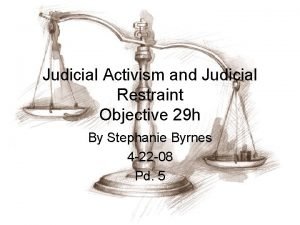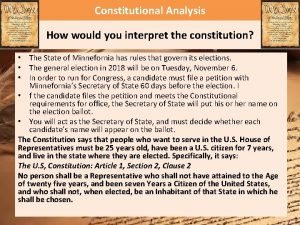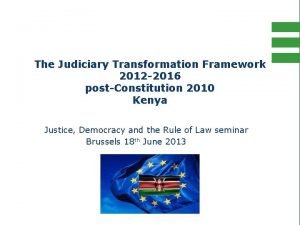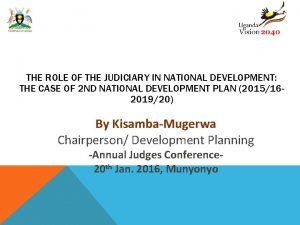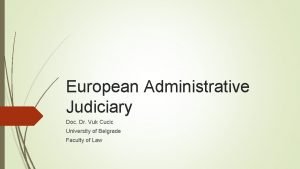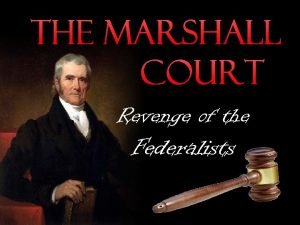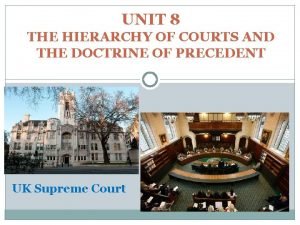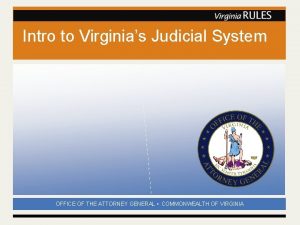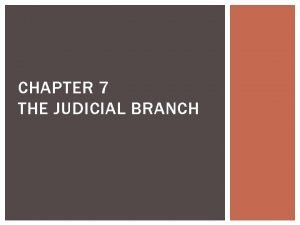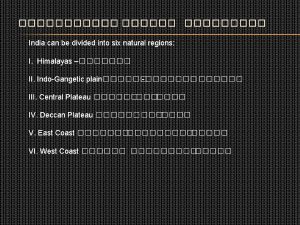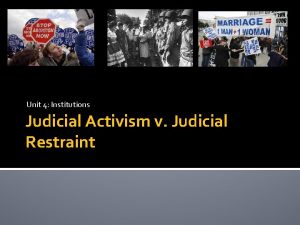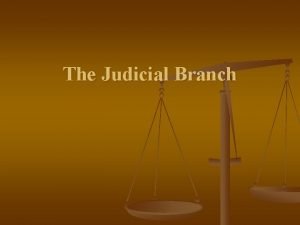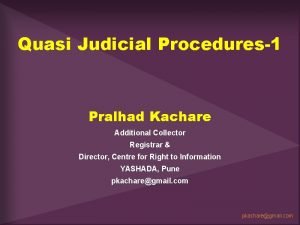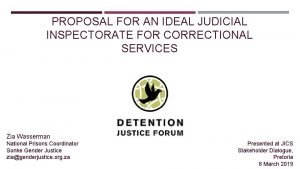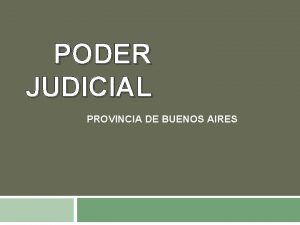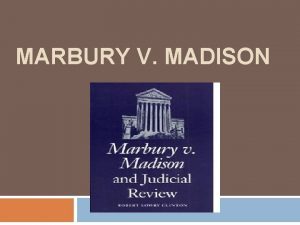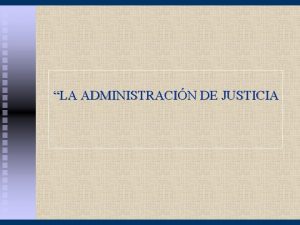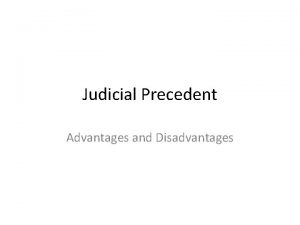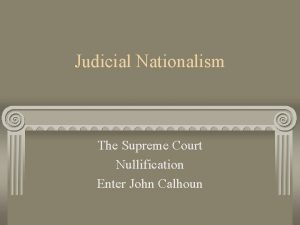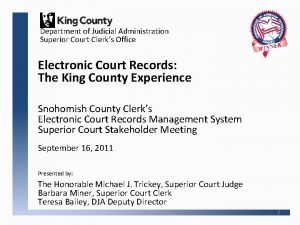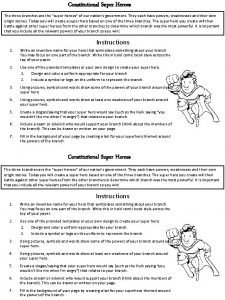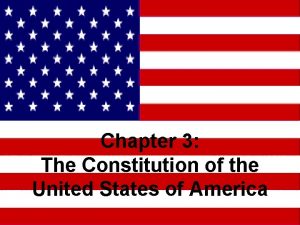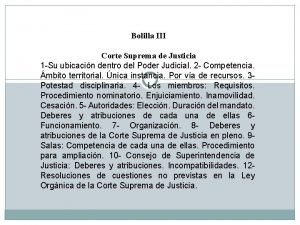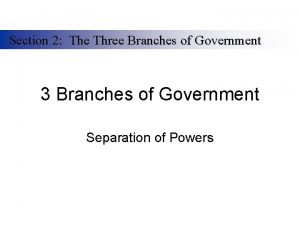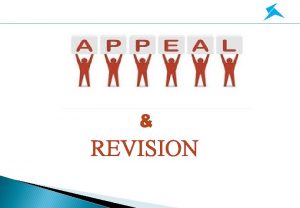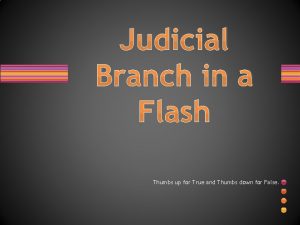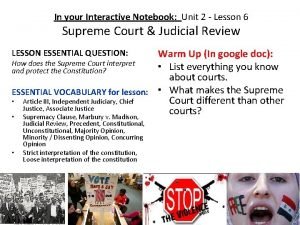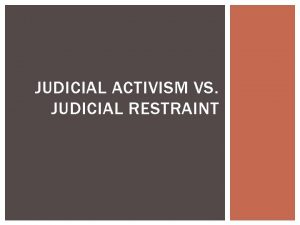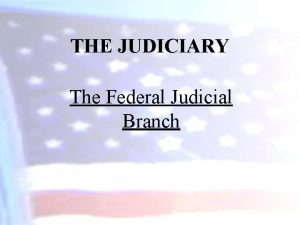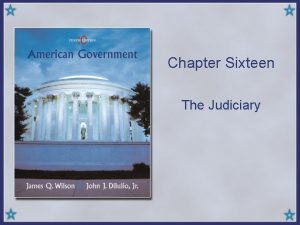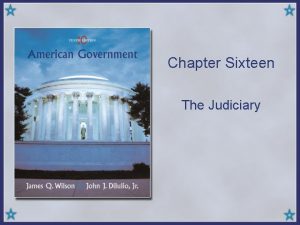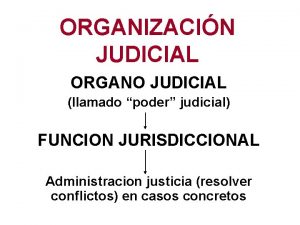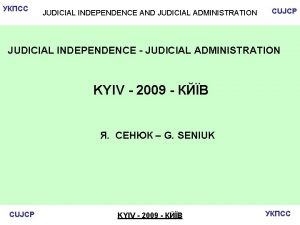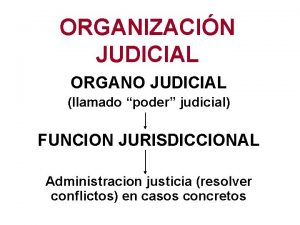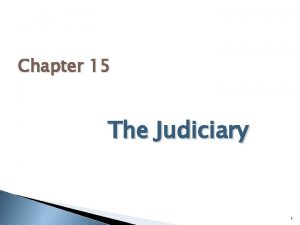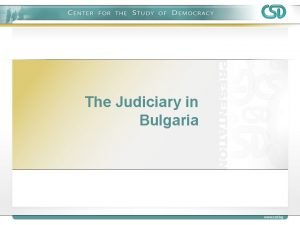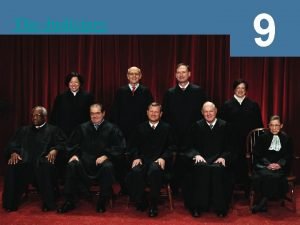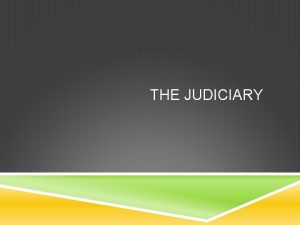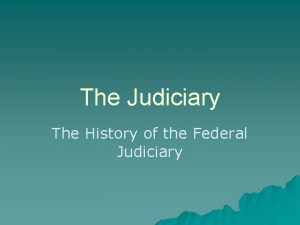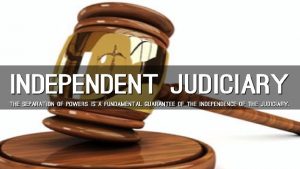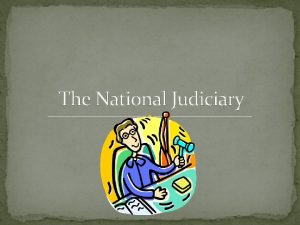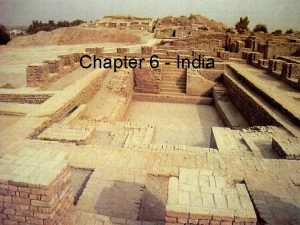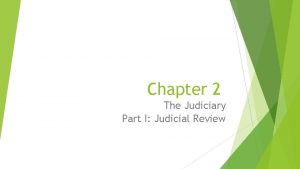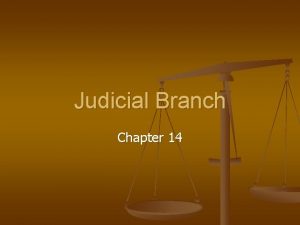CHAPTER NAME JUDICIARY Judiciary System of India Judicial










































- Slides: 42

CHAPTER NAME: JUDICIARY

� � � Judiciary System of India Judicial System or the court system is also the Judiciary System. The court has the power to make decisions and also enforce the law, solve disputes. Judiciary system consists of Judges and other magistrates; they form the bench or the core of the judiciary system. On 26 January 1950, the Indian Constitution was written and it is world’s largest constitution written. The constitution is the source of law in India and also the supreme law of India. Judicial System of India consists of Supreme Court, High Court, District Court or Subordinate Court.


The Supreme Court � � The Indian Constitution under Article 124(1) states that there shall be a Supreme Court of India consisting of a Chief justice of India (CJI) and 34 judges, including the CJI. The Jurisdiction of the Supreme Court of India can broadly be categorized into original jurisdiction, appellate jurisdiction and advisory jurisdiction.

� � Supreme Court of India Supreme Court at the apex of the Indian Judiciary is the highest authority to uphold the Constitution of India, to protect the rights and liberties of the citizens, and to uphold the values of rule of law. Hence, it is known as the Guardian of our Constitution.

� � � Composition of the Supreme Court Article 124(1) and Amendment act of 2008 states that there shall be a Supreme Court of India consisting of a Chief justice of India (CJI) and 34 judges including the CJI. Article 124(2) states that every judge of the Supreme Court shall be appointed by the President of India by warrant under his hand seal after consultation with such of the judges of the Supreme Court and of the High Courts in the states.

� � Required Qualification: To become a judge of the supreme court, besides being an Indian citizen, a person must be an advocate at a high court with a minimum of ten years experience, or High court judge with at least five years experience, or a distinguished jurist ie. expert in Law.

� Term of office : - The retirement age of the judges of the supreme court is 65 years. But, if found guilty of misuse of authority, a resolution will be passed in both the houses of parliament for the removal of the guilty person, and an impeachment procedure will commence.

Power and Function of Supreme Court � � There are three types of jurisdiction that supreme court has, namely: Original Jurisdiction Appellate jurisdiction Advisory jurisdiction

� � � Original Jurisdiction: The supreme court has the authority to hear certain types of cases for the first time. Cases that involved disputes over the Constitution can be brought directly to supreme court. Cases dealing with infringement of fundamental rights. Disputes that arises between the central government, and one or more state government. Disputes between two state government or more.

Appellate jurisdiction � Appellate jurisdiction refers to the power of a court to hear appeals from lower courts. Appellate jurisdiction includes the power to reverse or modify the lower court's decision. Appellate jurisdiction exists for both civil law and criminal law.

� � Advisory Jurisdiction: The supreme court advises the president and the council of ministers, on matters of Constitutional issues or issues of Public importances. The president can seek the advice of the supreme court but this is not binding on the president.

� � Judicial review: The Supreme Court is the defender of our fundamental rights. So, it has the power to issue writs, ie. Direction or orders for enforcement of the fundamental rights if limitation are placed on them. The court can order compensation to the victim and punishment to the offenders. So any law or policy made by the government that is not in accordance with the text or intention of the Constitution can be declared as illegal. This is known as judicial review.

� � Court of Records: All the cases brought before supreme court and where judgment have been given, are maintained as record by supreme court.

� � Contempt of court: Contempt of court, often referred to simply as " contempt ", is the offense of being disobedient to or disrespectful toward a court of law and its officers in the form of behavior that opposes or defies the authority, justice and dignity of the court. A similar attitude towards a legislative body is termed contempt of Parliament or contempt of Congress. On may 12, 2006 the supreme court directed a minister of the state of Maharastra to be jailed for one month on a charge of contempt of Court. 1990 chief minister of Uttar pradesh was sent to jail for one day for the same case.

� � Public interest Litigation: Any citizen of India can go to the court if the interest of the public has been affected by the deeds of the government. This is known as public Interest Litigation. The court then study the case and if necessary, issues orders to check the malpractices of Public officials and prevent the misuse of powers by the government.

High Court � The High Court is the supreme judicial body in a state. According to Article 214, each state of India shall have a High Court. However, Article 231 also mentions that there can be a common High Court for two or more states or for two or more states and a Union territory. The IAS Exam aspirants should know the number of High Courts in India. There are 25 High Courts in India, six having control over more than one State/UT. Delhi has a High Court of its own among the Union Territories. Each High Court shall consist of a Chief Justice and such other judges as appointed by the President of India.

� � � Composition of the High Court Every High Court comprises of a Chief Justice and other judges appointed by President. There is no fixed minimum number of judges for the High Courts. It varies from Court to Court and from State to State.

� � Qualifications and Tenure A person shall not be fit for appointment as a Judge of the High Court unless He is a citizen of India He should have held a judicial office in the territory of India for ten years He has been for at least 10 years an advocate of one or two or more High Court

� Retirement: -A high court judge retires at the age of 62. He or she also face impeachement on charges of misconduct as is the case with the judge of the supreme court.

Powers and Function of the High Court � � � A. Original Jurisdiction. B. Appellate Jurisdiction. B. Supervisory Jurisdiction.

HIGH COURT � The high courts of India are the principal civil courts of original jurisdiction in each state and union territory. However, a high court exercises its original civil and criminal jurisdiction only if the subordinate courts are not authorized by law. High courts may also enjoy original jurisdiction in certain matters, if so designated specifically in a state or federal law.

� � Appointment and Conditions of Office of a Judge of a High Court: Every Judge of a High Court shall be appointed by the President. In making the appointment, the President shall consult the Chief Justice of India, the Governor of the State (and also the Chief Justice of that High Court in the matter of appointment of a Judge other than the Chief Justice).

Subordinate Court � � The state are divided in to districts. Each of the districts has a district court. The District court and the courts bellow it are called subordinate courts. There are separate courts of civil and criminal cases. The Courts of the district Judges is the highest court for Civil justice. Subordinate courts under it are the court of civil judge and the court of the Munsif.

Subordinate Courts

Difference Between Civil and Criminal disputes

THE UNIFIED INDIAN JUDICIARY � � The Indian Judiciary is a single unified judiciary unlike the American One. In the USA, the courts of the various states are independent from each other, wheresa in India, all courts function under the ageies of the Supreme Court. If a citizen is dissatisfied with the judgment given any lower court, he or she can appeal to a higher court.

LOK ADALAT OR SPEEDY JUSTICE � � It was brought to the notice of Government of India that the number of courts and Judges were highly inadequate to deal with large no of cases that were being registered each day. As a result, there was a heavy backlog of cases in all the courts. In an effort to speed up the process of settling the cases. Lok Adalats were established by an act of parliament. Lok Adalat means “peoples court”. The first Lok Adalat was held in Delhi in 1985.

� � Membership and Composition of Lok Adalat The lok adalat comprises of a Chairman who shall be a siting or retired judicial officer. There shall be two members and one of them should be a lawyer. The members do not have any judicial role. They play the role of statutory intermediaries.

� � An advantage of Lok Adalats is that the parties to the Disputes can interact with the lok adalat judge Directly and explain their stand in the Dispute. This is not possible in a regular court of law. Another advantage with this system is that disputes can be brought before the lok Adalat directly intead of having to a regular court first.



� � � From which source India got the concept of Single order of court? (A) Government of India Act, 1935 (B) Government of India Act, 1919 (C) Pitts India Act, 1773 (D) None of the following

� Answer A

� � � Which qualification is wrong for being a judge in the Supreme Court? (A) It is compulsory to be a citizen of India. (B) He should be a respected jurist in the eyes of Parliament (C) Must be a judge in the High Court for at least 5 years (D) He should be a lawyer in the High Court for at least 10 years

� Answer B

� � � Which statement regarding the tenure of judges of the Supreme Court is not correct? (A) Judge of the Supreme Court can remain in office till the age of 65 years. (B) Judge of the Supreme Court gives his resignation letter to the Chief Justice (C) On the recommendation of Parliament, he can be removed by the President. (D) Supreme Court judge can be removed only in the condition of misconduct.

� � Answer B Explanation: A judge of the Supreme Court gives his resignation letter to the President

� � � Which of the following Article talks about the establishment of the Supreme Court? (A) Article 176 (B) Article 153 (C) Article 124 (D) Article 324

� Answer C

� � � Which of the following is not matched correctly? (A) Article 145: salary of judges (B) Article 143: Power of President to consult with the Supreme Court (C) Article 141: orders of the Supreme Court is applicable to all courts of India (D) Article 139: Power of Supreme Court to issue writ petition

� � Answer A Explanation: Article 145 is related to rules of the Supreme Court not the salary of judges.
 Judicial hierarchy in india
Judicial hierarchy in india Judicial activism vs restraint
Judicial activism vs restraint Judicial activism vs restraint
Judicial activism vs restraint Judicial activism vs restraint
Judicial activism vs restraint Judicial activism vs judicial restraint
Judicial activism vs judicial restraint Judicial activism vs judicial restraint
Judicial activism vs judicial restraint Judicial transformation framework
Judicial transformation framework Safe public and fair judiciary
Safe public and fair judiciary Department of judiciary
Department of judiciary Vuk cucic
Vuk cucic Whats the judiciary act
Whats the judiciary act Name
Name England hierarchy
England hierarchy Virginia judicial system
Virginia judicial system Judicial branch vocabulary
Judicial branch vocabulary In which region of india are
In which region of india are How to fill form without last name in india
How to fill form without last name in india Name the
Name the Marbury v madison apush
Marbury v madison apush Judicial activism examples
Judicial activism examples Judicial restraint
Judicial restraint Whitely v chappel
Whitely v chappel Quasi judicial procedure
Quasi judicial procedure Judicial inspectorate for correctional services
Judicial inspectorate for correctional services Estructura poder judicial
Estructura poder judicial Atribuciones del poder judicial argentina
Atribuciones del poder judicial argentina Marbury v madison judicial review
Marbury v madison judicial review Legislative, executive, and judicial,
Legislative, executive, and judicial, Qué es el poder judicial
Qué es el poder judicial Advantages and disadvantages of judicial activism
Advantages and disadvantages of judicial activism Judicial nationalism
Judicial nationalism Como resolver una prueba de habilidades y destrezas de aon
Como resolver una prueba de habilidades y destrezas de aon Georgia court system
Georgia court system King county superior court ecr
King county superior court ecr Constitutional superheroes
Constitutional superheroes Judicial branch picture example
Judicial branch picture example Mapa conceptual de los poderes del estado
Mapa conceptual de los poderes del estado Judicial branch powers
Judicial branch powers Appellate tribunal meaning
Appellate tribunal meaning Michigan judicial data warehouse
Michigan judicial data warehouse Judicial branch in a flash answer key
Judicial branch in a flash answer key Www.icivics.org login
Www.icivics.org login Louisiana judicial college
Louisiana judicial college
